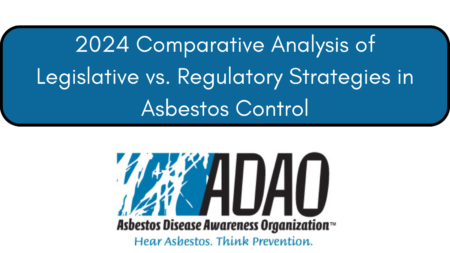Posted on December 27, 2023
Comparative Analysis of Legislative vs. Regulatory Strategies in Asbestos Control
The Asbestos Disease Awareness Organization (ADAO) and others have spent over seven years working to implement the Lautenberg Chemical Safety Act according to the law. The EPA has taken numerous landmark steps forward on asbestos, but the conflicting positions of major stakeholders make it highly likely that the final EPA Part I Chrysotile Asbestos Rule for one fiber and six conditions of use will be litigated, further delaying a comprehensive ban on asbestos.
Below is a comparative analysis of two approaches to banning asbestos: the legislative route through the Alan Reinstein Ban Asbestos Now Act (ARBAN) and the regulatory path of the EPA’s Chrysotile Asbestos Part I Final Rule. Although the outcome of the EPA rulemaking is uncertain, the most likely scenarios all have a high risk of litigation and consequent delay, underscoring the benefits of the legislative path and further strengthening the need to move the Alan Reinstein Ban Asbestos Now (ARBAN) Act (S.1069 and H.R.2402).
Legislation: Alan Reinstein Ban Asbestos Now Act (ARBAN)
- Overview: ARBAN targets all six asbestos fibers, including Libby Amphibole, advocating for a total ban.
- Scope of Ban: ARBAN’s approach is to completely prohibit the commercial import, manufacture, and use of these fibers, ensuring that all conditions of use are eliminated.
- Legal Implications: As an Act of Congress, ARBAN would maximize certainty and prevent delay because stakeholders could not file legal challenges.
- Advantages: ARBAN delivers a comprehensive and protective health and safety standard, assuring prevention of asbestos exposure and fully protecting workers and the public from harm.
Regulation: EPA’s Chrysotile Asbestos Part I Final Rule
- Focus on Chrysotile Asbestos: Prohibits chrysotile asbestos only.
- Six Conditions of Use: Prohibits only six specific uses and does not address other current or future uses.
- Balancing Factors: The regulatory approach aims to balance industry impact, enforceability, and health risks.
- Incremental Strategy: Provides only a partial solution and may invite broader regulations or future legislative actions like ARBAN to address gaps in public health protection.
Three Probable Scenarios for EPA’s Chrysotile Asbestos Rule
- Two-Year Transition Period: Industry is certain to see a two-year deadline for compliance as too short and will challenge it in court, resulting in potential delays in implementation.
- Five-Year Transition with Emissions Critical Exposure Level (ECEL) for worker protection: Likely to be viewed as too short by industry but too long by other stakeholders, resulting in complex legal battles involving multiple stakeholders with different agendas.
- Lengthy transition period (15-25 years) with different deadlines for companies based on the number of plants to be converted: Certain to be challenged by unions and public interest groups and may pit companies against each other, resulting in complex multi-party litigation and lobbying to reconsider and modify the rule that could lead to years of further rulemaking.
Overall Comparison and Conclusion
- Legislation Strengths: ARBAN provides a comprehensive and immediately enforceable ban, ensuring optimal public health protection.
- Regulatory Challenges: The regulatory path faces likely litigation and implementation complexities that will delay public health protection.
- Key Takeaway: A legislative ban like ARBAN offers comprehensive and certain health protection compared to the uncertainty, delay, and likely litigation of the regulatory path.
Join this movement to ban asbestos today. Send your letter to Congress – Tell Congress: Americans need the ARBAN Act now!
Linda Reinstein

